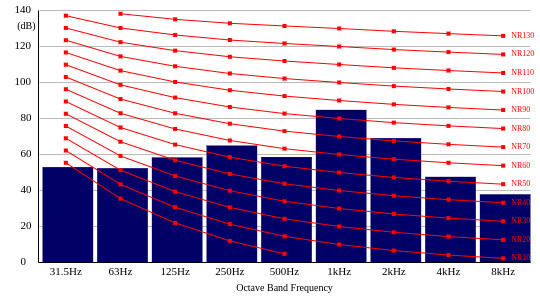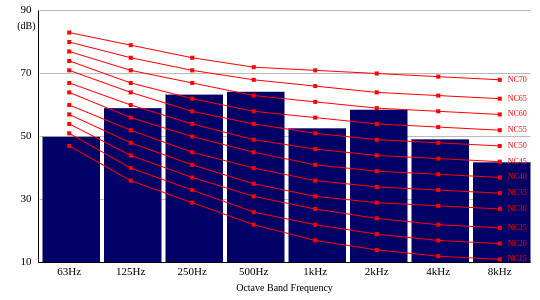Noise Rating and Noise Criterion are similar methods for assessing sound levels, generally used for indoor noise assessments, often for noise related to air conditioning systems. Check which method is used in your region, but generally speaking the Noise Criterion method is used in the US and Noise Rating in Europe and much of the rest of the world.
Both methods provide you with a single number result, which takes into account the response of the human ear and is much easier to handle than looking at the eight to ten dB values returned for the full octave band spectrum.
To make either NR or NC assessments you need a sound level meter that is capable of measuring in the individual octave bands - preferably a meter that measures in all bands at the same time, referred to as a real-time octave band meter.
From the octave band measurements you can plot and work out the NR and NC manually, or measurements can often be downloaded to software to make these calculations for you. Some sound level meters have the NR and NC calculations built in to the meter itself.
The sound level meters at the bottom of this page all have the NR and NC calculations built in and can display the results either on-screen or after downloading to the software.
Commonly used in Europe, the noise rating value is generally used for assessing the indoor noise levels, often in connection with air conditioning units and similar indoor equipment. Some example applications along with typical NR levels are:
The sound level meter carries out all the calculations for you. NR calculations are carried out from the octave band measurement results. The octave band measurements are compared with the standard Noise Rating Curves to find the highest level that crosses one of the curves. This becomes the single Noise Rating value.
The NR calculation process is better shown on a chart.

The blue bars show the octave band measurements. The red lines are the standard noise rating curves. This example would return a noise rating value of 85 dB.
Commonly used in the US, the noise criterion value is for assessing the indoor noise levels, often in connection with air conditioning units and similar indoor equipment. Some example applications along with typical NC levels are:
The sound level meter carries out all the calculations for you. NC calculations are carried out from the octave band measurement results. The octave band measurements are compared with the standard Noise Criterion Curves to find the highest level that crosses one of the curves. This becomes the single Noise Criterion value.
The NC calculation process is better shown on a chart.

The blue bars show the octave band measurements. The red lines are the standard noise criterion curves. This example would return a noise criterion value of 61 dB.